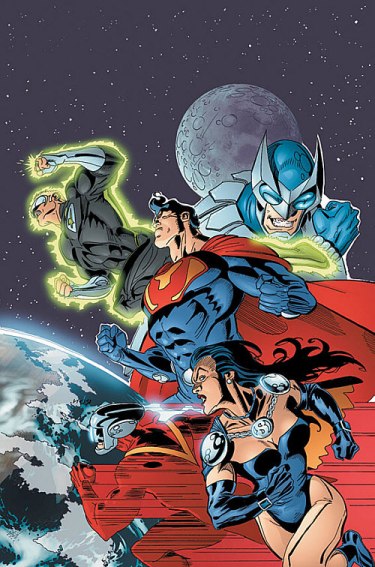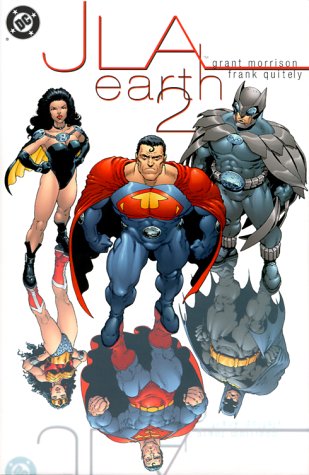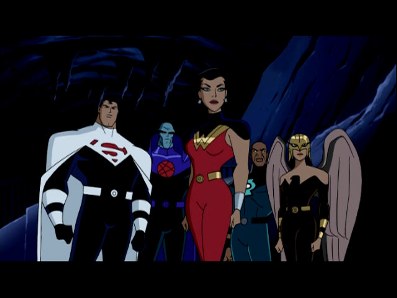Most people are familiar with the Justice League, DC Comics’ superteam usually anchored by the big three of Batman, Superman and Wonder Woman. Lesser known are the Crime Syndicate, evil doppelganger versions of these heroes that come from another dimension.
Originally introduced before the Crisis on Infinite Earths miniseries collapsed the multiverse, the Crime Syndicate was a supergroup from Earth-3, a world where major historical events were reversed and where the heroes we know and love were villains. Instead of Superman we had Ultraman, also a Kryptonian, who became stronger by exposure to kryptonite rather than weaker, gainin a new power each time. Instead of Wonder Woman there was Superwoman, also an Amazon with a magic lasso that could change shape. Batman’s counterpart was Owlman, the Flash’s was Johnny Quick, and Power Ring stood in for Green Lantern with a magic ring more like the original Green Lantern’s.
As usually happens with these alternate dimensions, the Crime Syndicate became aware of the Justice League of Earth-1 and the Justice Society of Earth-2 and, wanting a challenge (they committed crimes with ease on their own world), they attacked both teams. In the end they were defeated but returned from time to time to harass the heroes.

This ended in the aforementioned Crisis on Infinite Earths when Earth-3 was destroyed by an antimatter wave. The only survivor of that world was the infant son of Lex Luthor (a hero on Earth -3), Alexander Luthor, who featured prominently in Crisis and the later Infinite Crisis. The Crime Syndicate, however, was no more.
Earth 2
However, the Crime Syndicate concept was too cool to let go completely. So in 1999, Grant Morrison, who had been writing the Justice League comic, wrote a graphic novel, JLA: Earth 2, with art by Frank Quitely, which reimagined the Crime Syndicate characters. This time they resided in an antimatter universe. Lex Luthor from the evil universe escapes to the main DC universe to bring the Justice League to his world to help save it. Only, that task turns out to be more difficult than they imagine. Especially in a world where President Benedict Arnold takes the place of George Washington on the one dollar bill and where the British Colonies fought for Independence from the United States. The two teams realize that it’s not all about good vs. evil in the end, and that it’s difficult to do good in a world where almost everything turns to evil. It’s a story that excels by not having it be about force, but about choice.

Morrison also brings some modern touches to the Crime Syndicate, updating them for a modern audience. Owlman, for example, originally had a costume much like Batman’s, but with a ridiculous owl head cowl. In this graphic novel, his costume more closely resembles that of Nite Owl from Watchmen. Johnny Quick is now a junkie, relying on drugs to keep him fast. Extra points to the graphic novel for making Aquaman (who doesn’t have a doppelganger) into a bad ass.
Post Infinite Crisis
After Infinite Crisis brought back the multiverse (reversing the effects of Crisis on Inifinite Earths), the Crime Syndicate reappeared as The Crime Society of America with an expanded roster, once again residing on Earth-3, though it appears that this is a new Earth-3 and not the original (continuity can be dizzying, folks).
Superfriends
In the old Superfriends show from the 70s, they did an episode where Superman is trying to stop Mt. Vesuvius from exploding and gets shifted into an alternate dimension, trading places with his counterpart. Again, in this universe, the Superfriends are evil and commit crimes. Instead of the Hall of Justice, their headquarters is the Hall of Evil. But apparently fashion choices in this world are different, too. To highlight their evil natures, Aquaman has an eyepatch (Arrrrquaman?), Robin has a moustache (I didn’t even know he shaved) and Batman’s costume is red instead of blue and grey. While this seems cheesy now, I admit to being excited by this as a child.
Animated Justice League
A similar group appeared on the animated Justice League/Justice League Unlimited cartoon. The Justice Lords were the actual members of the Justice League from an alternate future where they had taken control of the world in an effort to stop crime and war. They become fascists, though, betraying their ideals, highlighted by the fact that Superman kills Lex Luthor in this timeline.

Like in the comics, the Justice Lords discover the existence of the mainstream Justice League and, being bored with their own world, seeks to change places with their counterparts and convert their world as well. The League are imprisoned in the Justice Lords’ world, but eventually escape and confront their counterparts. This whole storyline has major repercussions that continue throughout the series for years afterward as the people and governments of the mainstream timeline see what the Justice League could become and start to put failsafes in place to prevent that eventuality.
The Brave and the Bold
Referred to as the Injustice Syndicate, a team of evil versions of many of the heroes of the series appears in an episode entitled “Deep Cover for Batman.” In it, Owlman travels to Batman’s dimension where he is beaten and imprisoned by Batman. Batman then travels to Owlman’s dimension and assumes his identity as leader of the Injustice Syndicate. This team consists of Blue Bowman (the counterpart of Green Arrow), Scarlet Scarab (Blue Beetle), Dyna-Mite (The Atom), and Silver Cyclone (Red Tornado). Batman ends up teaming up with The Red Hood, the alternate dimension’s version of The Joker who in that universe is a hero.
Crisis on Two Earths
Recently, the Crime Syndicate was featured in a full-length direct to DVD animated feature, Crisis on Two Earths. A copy of the movie was not available at the time I wrote this post, however, I intend to do a separate review when I can get my hands on it.
Special Mention – The Squadron Sinister
DC was not the only one to create a team of evil Justice League characters. In 1969 Roy Thomas and Sal Buscema created the Squadron Sinister for Marvel, clearly basing them on DC’s Justice League characters. Hyperion took the place of Superman, Nighthawk was Batman, Doctor Spectrum was Green Lantern and the Whizzer (an unfortunate name) was the Flash. They were pitted against Avengers Thor, Iron Man, Captain America and Goliath.
Furthermore, Thomas and Buscema later introduced the Squadron Supreme, good versions of these characters. Essentially good doppelgangers of the evil doppelgangers of the Justice League. While this is confusing, Mark Gruenwald later wrote a 12-issue series focusing on the Squadron Supreme (appropriately titled, Squadron Supreme) tackling issues that later on would inform books like The Authority, issues of how superbeings would truly use their powers to help change the world. It’s worth checking out the collection.
Feel free to chime in on any versions or variations I missed in the comments.
Rajan Khanna knows entirely way too much about comic characters. In another dimension there is an evil opposite version of him (with a goatee) who hates cats, doesn’t write fiction, sleeps well all the time, and is an accountant. Thankfully, the two have never met.










